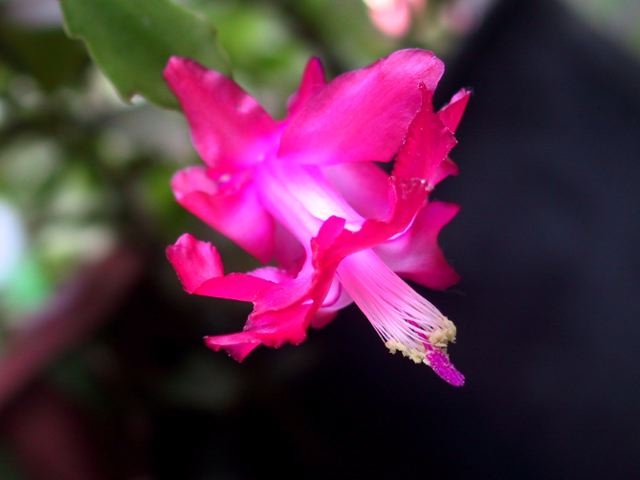Thanksgiving Cactus
(Schlumbergera truncata)
Thanksgiving Cactus (Schlumbergera truncata)
/
/

jam343
CC BY 2.0
Image By:
jam343
Recorded By:
Copyright:
CC BY 2.0
Copyright Notice:
Photo by: jam343 | License Type: CC BY 2.0 | License URL: https://creativecommons.org/licenses/by/2.0/ | Uploader: jam343 | Publisher: Flickr |


















Estimated Native Range
Summary
Schlumbergera truncata, commonly known as Thanksgiving Cactus or Holiday Cactus, is an evergreen succulent native to the coastal mountains of southeast Brazil, where it thrives in the shady, humid environment of tropical rainforests, often growing as an epiphyte on trees. It reaches a height of 0.8-1 feet and a width of 1-2 feet, with arching, segmented stems that resemble leaf-like structures. The flowers are showy, with vibrant, tubular blooms in shades of red, orange, pink, and white, appearing at the tips of the stems. The flowering season in its native habitat corresponds to the Southern Hemisphere’s autumn, around May, while in the Northern Hemisphere, it typically flowers from October to November, requiring short days and long nights to induce blooming.
Thanksgiving Cactus is valued for its striking flowers and ease of care, making it a popular houseplant, especially during the holiday season. It is often used as a decorative indoor plant in pots or hanging baskets. While it prefers bright, indirect light, it can tolerate lower light conditions. Overwatering should be avoided, and a well-draining potting mix is essential to prevent root rot. It is not typically prone to serious pest or disease problems, but overwatering can lead to root rot, and it can suffer from common houseplant pests like mealybugs and aphids. Thanksgiving Cactus is not known for being invasive when grown outside its native range, but it should be protected from frost if grown outdoors in temperate regions.CC BY-SA 4.0
Thanksgiving Cactus is valued for its striking flowers and ease of care, making it a popular houseplant, especially during the holiday season. It is often used as a decorative indoor plant in pots or hanging baskets. While it prefers bright, indirect light, it can tolerate lower light conditions. Overwatering should be avoided, and a well-draining potting mix is essential to prevent root rot. It is not typically prone to serious pest or disease problems, but overwatering can lead to root rot, and it can suffer from common houseplant pests like mealybugs and aphids. Thanksgiving Cactus is not known for being invasive when grown outside its native range, but it should be protected from frost if grown outdoors in temperate regions.CC BY-SA 4.0
Plant Description
- Plant Type: Subshrub, Succulent
- Height: 0.8-1 feet
- Width: 1-2 feet
- Growth Rate: Moderate
- Flower Color: Yellow, Orange, Pink, Purple, Red, White
- Flowering Season: Fall, Winter
- Leaf Retention: Evergreen
Growth Requirements
- Sun: Part Shade
- Water: Medium
- Drainage: Fast
Common Uses
Bird Garden, Hummingbird Garden, Low Maintenance, Potted Plant, Rock Garden, Showy Flowers, Street Planting
Natural Habitat
Coastal mountains of southeast Brazil, tropical rainforests, often growing as an epiphyte
Other Names
Common Names: Thanksgiving Cactus, Claw Cactus, Linkleaf, Crab Cactus, Yoke Cactus, Cactus De Noël, Novemberkaktus
Scientific Names: , Schlumbergera truncata, Schlumbergera bridgesii, Zygocactus truncatus, Epiphyllum truncatum, Epiphyllum altensteinii, Epiphyllum ruckerianum, Cactus truncatus, Epiphyllum delicatum, Epiphyllum truncatum var. wagneri
GBIF Accepted Name: Schlumbergera truncata (Haw.) Moran